First impressions matter, especially when it comes to your home’s exterior. A captivating house exterior not only boosts curb appeal but also reflects your personal style and sets the tone for your entire property. That’s why exterior design ideas are so popular—they allow homeowners to express creativity, enhance value, and stand out in their neighborhood.
In this article, you’ll uncover a variety of inspiring ideas to transform your home’s facade, from timeless classics to modern trends. Whether you’re looking to add a splash of color, incorporate unique architectural details, or create welcoming outdoor spaces, these ideas will help you make a lasting impression and elevate your home’s exterior to new heights.
1. Bold Color Accents on Doorways for Instant Curb Appeal
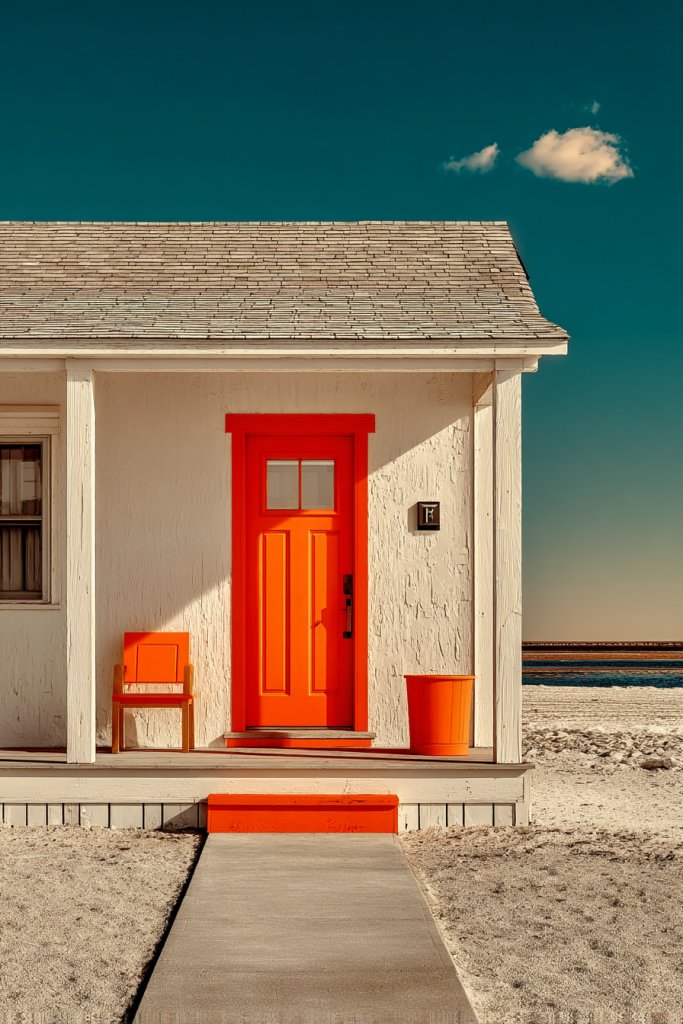
Ever driven by a home that just screams ‘welcome’ without saying a word? A bold-colored door instantly transforms a bland facade into an eye-catching statement. If your house feels a bit tired or uninspired, a splash of vibrant paint might be all you need to turn heads.
Imagine a front door painted a rich navy or a fiery red, standing out against neutral siding. The glossy finish reflects sunlight, making your entry pop. Complement this with contrasting trim or decorative hardware, creating a lively focal point. The texture of the paint adds depth, giving the door a fresh, inviting look.
Choose colors that match your overall exterior palette or go bold with unexpected hues like mustard or emerald. For seasonal charm, swap out accents—like a bright door in summer or a deep hue in winter. Smaller homes benefit from bright pops, while larger properties can handle more subdued, sophisticated shades.
Start by cleaning the door surface thoroughly, then sanding any rough patches. Use painter’s tape to protect adjacent areas. Select weather-resistant exterior paint in your chosen color and apply at least two coats for durability. Adding a clear sealant prolongs the vibrancy and protects against the elements. Hardware updates, like new handles or knockers, enhance the visual impact.
Add a decorative hoop or custom monogram for a personal touch. Pair the door with a matching or contrasting porch accent—like a soft cream or charcoal trim. Incorporate seasonal wreaths or banners that complement your color choice for a dynamic look. Small details like painted stripes or stencils can also add a playful vibe.
Bold door accents are quick wins that boost curb appeal without a major overhaul. They reflect personality and style, making your home more inviting. Go ahead—pick a daring hue and watch your house become the neighborhood’s new favorite spot.
2. Stylish House Number Displays with Modern Materials

Finding your house numbers can feel like searching for a needle in a haystack, especially at night. Outdated or hidden numbers diminish curb appeal and can even cause delivery confusion. Modern house number displays solve both problems with style and practicality.
Picture sleek metal numbers with a matte black finish mounted on a textured stone wall. Or think of illuminated acrylic numbers casting a soft glow in the dark. These modern designs add a contemporary edge, balancing minimalism with high visibility. The contrast against your exterior creates a clean, polished look that welcomes visitors.
Choose materials like brushed stainless steel, bronze, or frosted acrylic to match your home’s architecture. For rustic homes, distressed metal or wood-backed numbers add charm. For ultra-modern homes, go with backlit LED options that make numbers pop at night. Placement can be vertical, horizontal, or staggered for a custom feel.
Start by selecting a style that complements your exterior. Measure carefully to ensure proper spacing and visibility. Use a level and drill for precise mounting. For illuminated options, plan wiring routes or opt for solar-powered units. Secure the numbers firmly with appropriate anchors, making sure they are flush and straight. Double-check visibility from the street.
Add a backplate or frame in contrasting materials for extra flair. Incorporate house name or street name for a personalized touch. Use creative mounting angles or offset placements to add visual interest. Coordinate with mailbox or porch lighting for cohesive curb appeal.
Modern house numbers instantly elevate your home’s style and functionality. They make your address easy to find and add a sleek, contemporary vibe. Small upgrade, big impact—your house will stand out for all the right reasons.
3. Incorporate Eye-Catching Exterior Lighting Fixtures
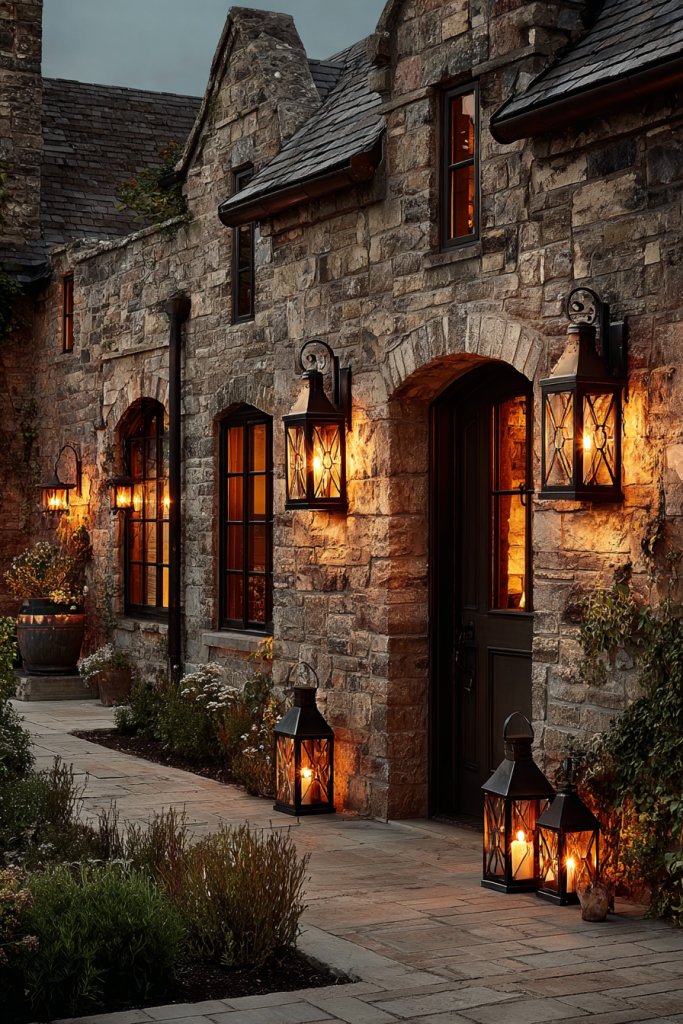
Darkness can hide your home’s best features and make it feel unwelcoming. Proper exterior lighting not only boosts security but also highlights your home’s architecture. Eye-catching fixtures turn your facade into a visually appealing showcase after sunset.
Think of warm wall sconces flanking the front door, casting gentle light on textured siding. Or imagine pathway lanterns lining the walkway, their flickering glow guiding guests inside. Decorative fixtures with intricate designs or modern geometric shapes add personality and charm, transforming your exterior into a nighttime masterpiece.
Select fixtures that match your home’s style—rustic lanterns for country homes, sleek sconces for modern designs. Solar-powered lights offer easy installation and energy savings. For larger properties, consider statement fixtures like oversized pendants or uplighting on architectural features. Seasonal lighting, such as string lights or fairy lamps, adds festivity during celebrations.
Start by assessing dark spots and planning fixture placement for optimal coverage. Choose weatherproof, UL-listed fixtures suited to your climate. Mount sconces at eye level beside the door, ensuring wiring is concealed and secure. Install pathway lights along the walkway, making sure they are evenly spaced for a balanced look. Use timers or smart controls to automate lighting, saving energy and effort.
Add decorative elements like vintage-inspired lanterns or sleek modern sconces. Incorporate dimmable features to adjust ambiance. Use fixtures with unique finishes—antique bronze, matte black, or brushed nickel—to complement your exterior palette. For a cozy touch, place candles or flameless lanterns on porches.
Thoughtfully chosen lighting fixtures turn your home into a welcoming beacon. They enhance safety, style, and curb appeal all at once. A well-lit exterior invites admiration and makes your home memorable, even from a distance.
4. Upgrade to a Custom Front Door with Unique Materials
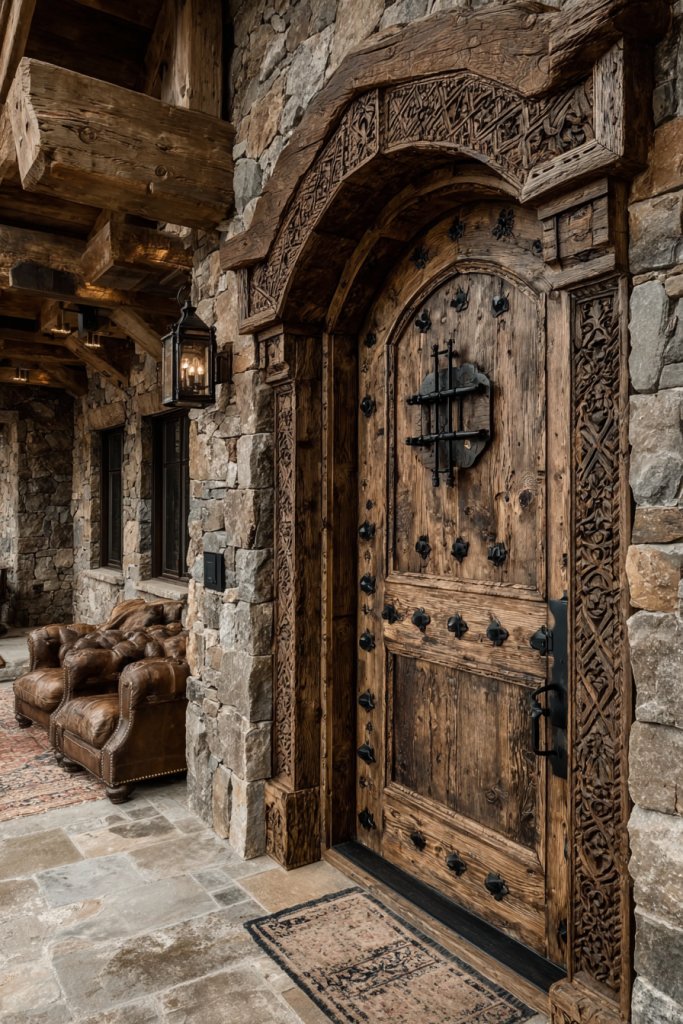
Your front door is more than just an entry point—it’s the focal point of your home’s exterior. An ordinary door fails to make a statement or reflect your personal style. Upgrading to a custom door instantly elevates your home’s first impression.
Imagine a handcrafted wooden door with decorative carvings or intricate glass panels that catch the light. Or picture a sleek fiberglass door with a textured finish that resembles aged metal. These unique materials and designs turn a mundane entry into a work of art, setting the tone for your entire exterior.
Choose from natural wood for warmth and character, or opt for modern composites that require less maintenance. Incorporate decorative glass inserts or metal accents for added flair. Styles range from traditional panel designs to ultra-modern slab doors with clean lines. Seasonal elements like bold paint or finishing details can also be swapped to match trends.
Start by selecting a style that complements your home’s architecture. Measure opening dimensions precisely before ordering. Consider hardware options—handles, knockers, and hinges—that match your aesthetic. Professional installation ensures proper sealing and security. Finish with weatherproof paint or stain to protect the material and enhance appearance.
Add custom hardware such as vintage bronze handles or sleek chrome fixtures. Incorporate decorative panels or textured glass for privacy and style. Paint the door in a bold hue or subtle tone, depending on your preference. Personal touches like engraved plaques or unique knockers make it uniquely yours.
A custom front door is a statement piece that boosts curb appeal and home value. It reflects your personality and taste, making your home truly one-of-a-kind. With the right choice, your entry becomes an inspiring welcome for all visitors.
5. Add a Cozy Covered Porch or Portico
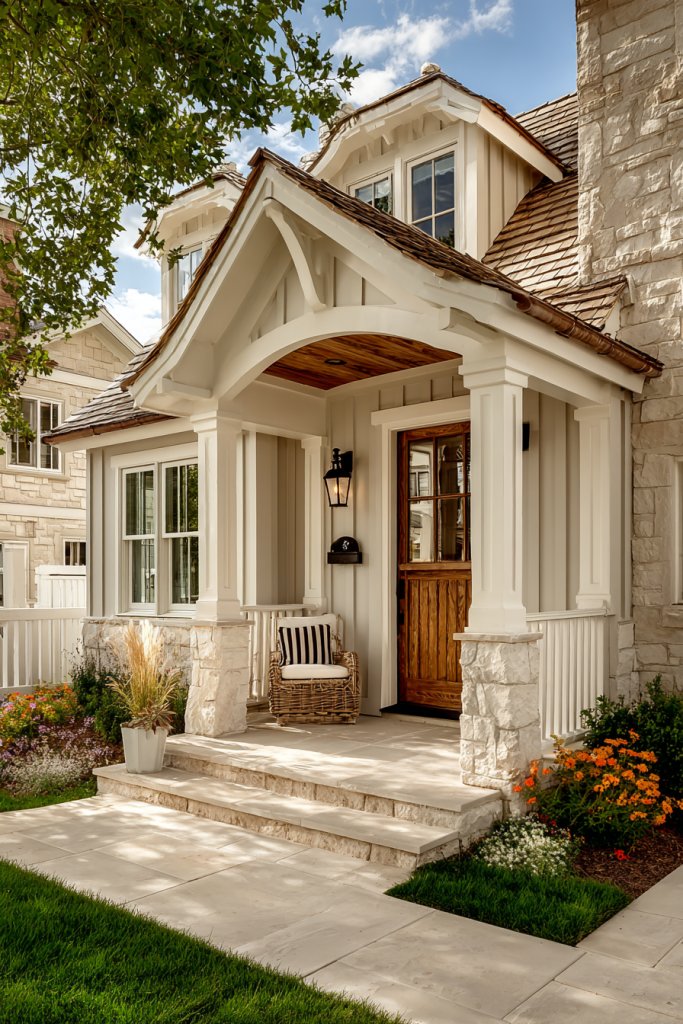
Feeling like your entry lacks warmth and shelter? A covered porch or portico creates a welcoming transition from street to home. It also offers a practical space to relax or greet guests without exposing them to the elements.
Visualize a charming porch with rustic wooden columns supporting a gabled roof. Comfortable seating, like a swing or cushioned bench, invites you to unwind. Decorative trim and hanging lanterns enhance the cozy vibe. The roof extends over the walkway, protecting visitors from rain or sun, while adding architectural character.
Choose from classic columns, modern steel supports, or decorative brackets based on your home’s style. Small porches fit narrow front yards, while larger porticos create grand entrances. Seasonal accents like fabric curtains or seasonal wreaths can change the mood. Incorporate built-in benches or planters to personalize the space.
Begin by assessing the space and determining the size and style of the porch or portico. Use durable framing materials—pressure-treated wood, steel, or concrete—and ensure structural stability. Add flooring, such as composite decking or stamped concrete. Install roofing and lighting fixtures, then finish with weatherproof paint or stain. Safety measures include proper anchoring and adherence to local building codes.
Decorate with colorful cushions, outdoor rugs, or string lights for ambiance. Incorporate seasonal decor like pumpkins or wreaths. Add a small table or storage chest for convenience. Use decorative trim or unique brackets to reflect your personal style.
A covered porch transforms your home’s facade into a warm, inviting space. It increases curb appeal and offers a functional outdoor living area. With a little effort, your entry becomes a charming retreat that welcomes everyone.
6. Use Textured Cladding for Visual Interest
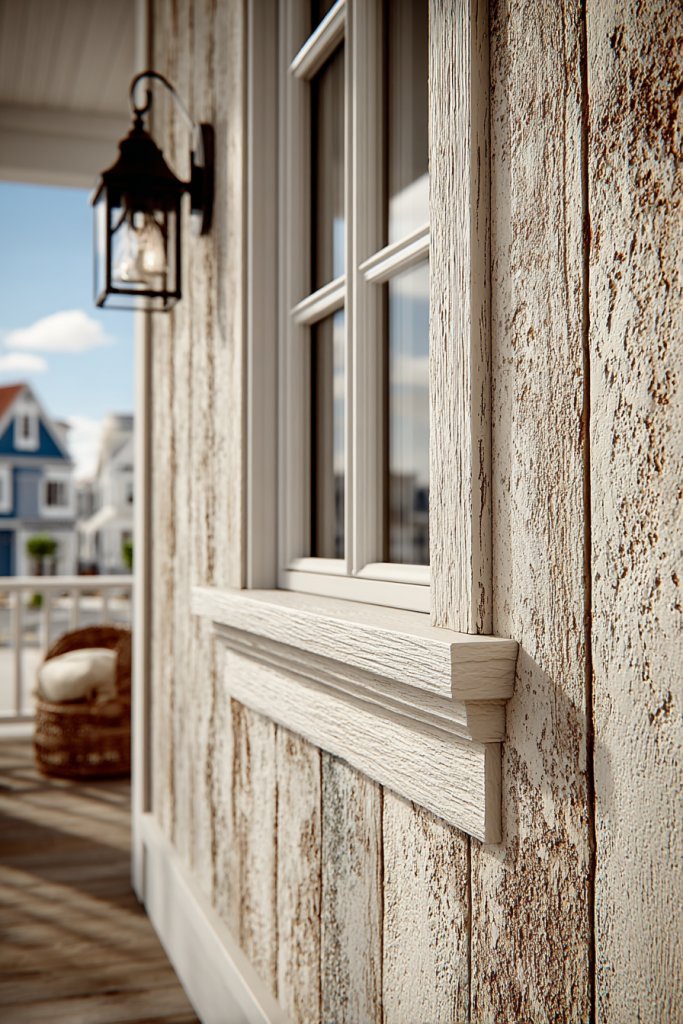
Flat, monotone exteriors can feel dull and uninspired. Textured cladding adds depth and character, making your home stand out in any neighborhood. It also increases visual appeal, giving your house a richer, more layered look.
Picture a facade accented with stone veneer or brick, creating a tactile surface that catches light differently throughout the day. Imagine textured horizontal siding or shingle panels adding variety and dimension. These materials bring a natural, earthy vibe or a sophisticated modern edge, depending on your choice. The varied textures create shadows and highlights, enriching the overall aesthetic.
Select materials based on your style—rough-hewn stone for rustic charm, sleek fiber cement for modern minimalism. Mix textures strategically to avoid cluttered looks. Consider combining smooth and textured finishes on different sections for visual balance. Seasonal changes can be reflected with warm-toned stone or darker brick for fall and winter.
Begin by preparing the surface, ensuring it’s clean and stable. Install the cladding using appropriate fasteners and weather-resistant adhesives. For stone veneer, use a mortar base; for siding, follow manufacturer instructions. Seal joints and edges to prevent water infiltration. Finish with protective coatings if needed to preserve color and texture. Regular maintenance prolongs the aesthetic.
Combine different textures with color accents—like dark mortar joints or painted trim—to heighten visual interest. Use textured panels around entrances or windows for a subtle upgrade. Add decorative trims or corbels to emphasize architectural features. Seasonal accents like wreaths or lighting enhance the textured backdrop.
Textured cladding elevates curb appeal with a durable, stylish finish. It offers a distinctive look that reflects craftsmanship and personality. When done right, it makes your home not just a shelter but a statement piece that exudes character.
7. Install Decorative Window Shutters for Charm and Functionality
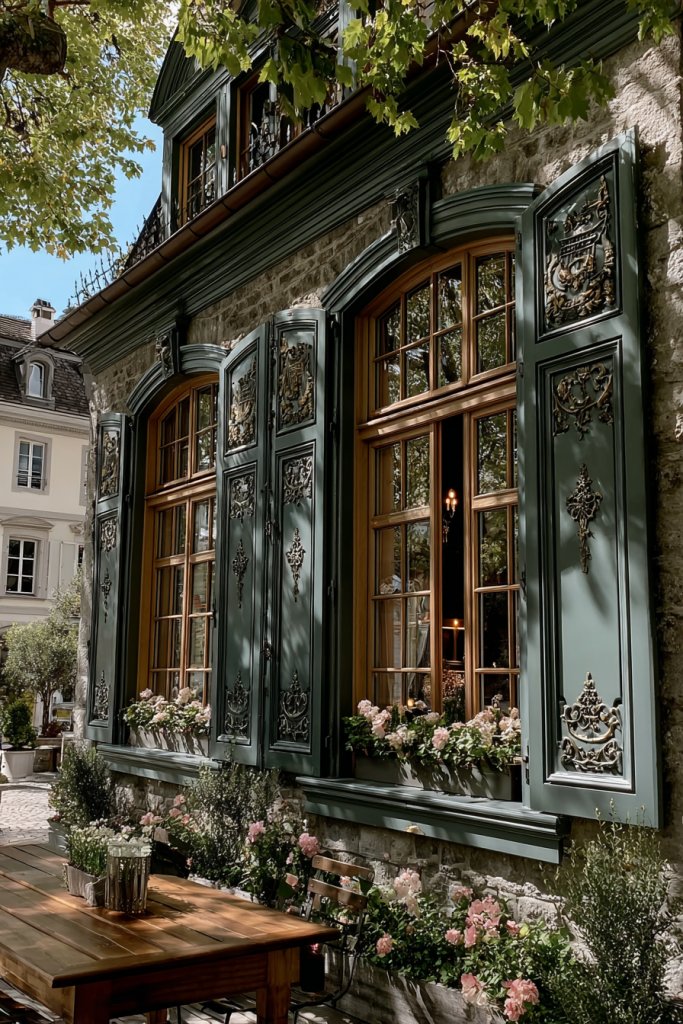
Plain windows can make a home look flat and uninteresting. Decorative shutters provide charm, character, and an extra layer of architectural interest. They also offer functional benefits like protecting windows during storms or adding privacy.
Visualize traditional wood shutters painted in a bold color that frames the window perfectly. Or imagine louvered shutters adding a classic touch, casting shadows across the glass. Shutters with decorative carvings or ornate hinges turn simple windows into focal points. When closed, they add a charming, cottage-like appeal.
Choose from hinged, operable shutters for functionality, or fixed decorative ones for style. Material options include painted wood, composite, or metal—each with different maintenance needs. Coordinate shutter color with your exterior palette or opt for contrasting shades for drama. Style can range from rustic to sleek modern, depending on your home’s architecture.
Measure window dimensions carefully before purchasing shutters. Mount hinges securely on the wall, and ensure shutters swing freely without obstruction. For operable shutters, add locks or tiebacks for easy opening. Paint or stain surfaces to match your aesthetic, and seal surfaces for weather resistance. Regular maintenance keeps shutters looking their best.
Decorate shutters with decorative hinges, finials, or carved details. Use contrasting paint colors for a bold statement or subtle shades for elegance. Combine shutters with window boxes or decorative trim to enrich the exterior. Seasonal accessories like ribbons or banners can also personalize the look.
Decorative shutters transform ordinary windows into charming architectural features. They boost curb appeal and reflect your personal style. When thoughtfully chosen, shutters make your home more inviting and distinctive, giving you confidence in your exterior design choices.
8. Create a Symmetrical Façade with Balanced Landscaping
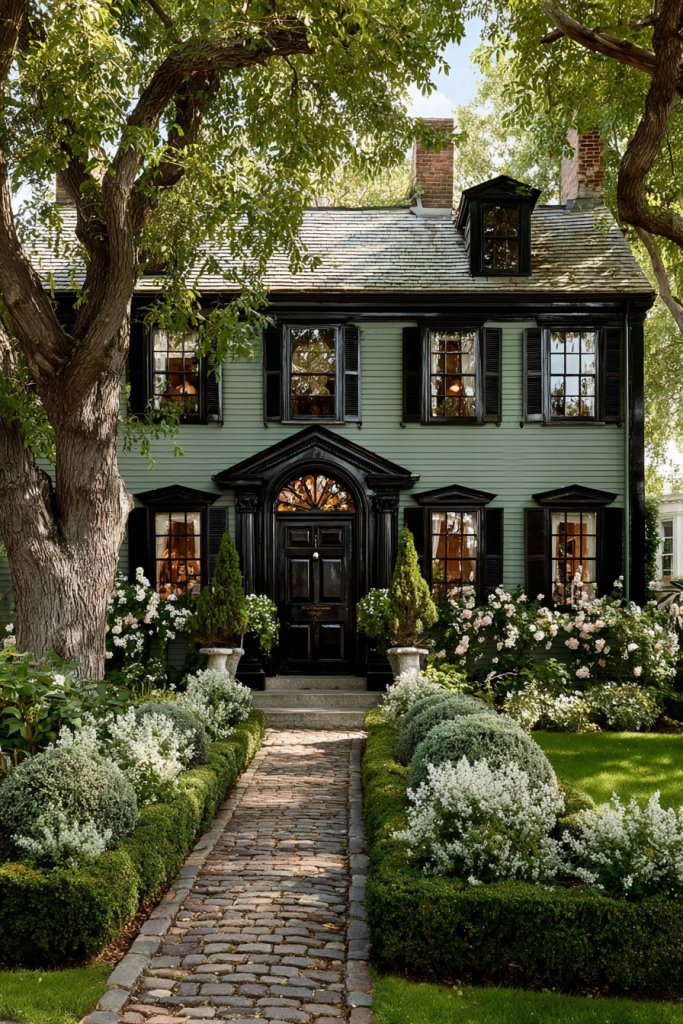
Homes that lack symmetry can feel unbalanced or chaotic. Creating a symmetrical façade with balanced landscaping offers harmony and order, making your home instantly more attractive. It’s like giving your house a sense of calm and stability.
Picture matching flower beds on either side of the front walkway, with identical shrubs and small trees. Symmetrical window placements paired with evenly spaced pathway stones create visual harmony. The balance in landscaping complements architectural features, framing the house beautifully. It’s all about creating a mirror image that feels natural, not forced.
Use formal designs with identical plantings, or go for a more relaxed symmetry with varied but balanced elements. Consider seasonal plantings for year-round appeal. For small yards, emphasize vertical elements like matching trellises or columns. Larger properties can include symmetrical features like fountains or sculptures.
Start by sketching your layout, marking where plants and pathways will go. Choose plants that thrive locally and require similar care levels for symmetry. Plant in pairs or clusters, maintaining equal spacing. Use mulch or edging to define beds sharply. Regular pruning and maintenance keep the symmetry crisp.
Add decorative stones, statues, or lighting fixtures symmetrically to enhance balance. Incorporate color themes that match your house’s palette for cohesion. Use different textures or heights in plantings for visual interest within the symmetry. Personal touches, like engraved stones or custom planters, make it uniquely yours.
A balanced landscape amplifies your home’s curb appeal and creates a welcoming atmosphere. It’s a proven way to elevate your property’s perceived value. Symmetry provides a sense of order that’s comforting and aesthetically pleasing, making your home the envy of the block.
9. Incorporate Vertical Garden Elements or Green Walls
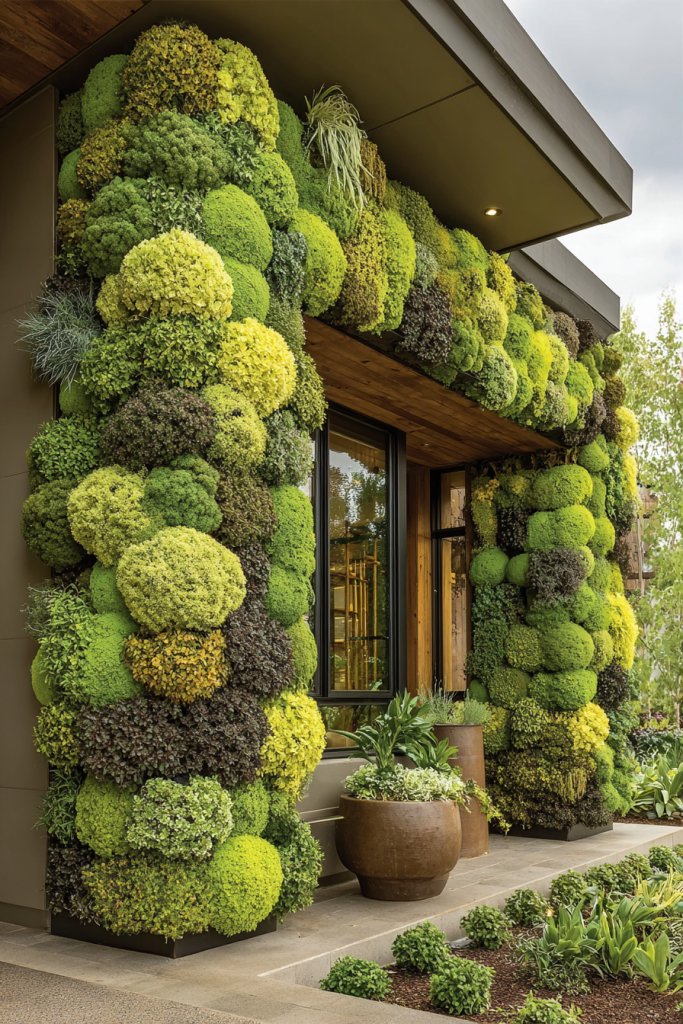
Limited yard space doesn’t mean you have to sacrifice greenery. Vertical gardens or green walls bring nature up close without taking up valuable ground. They add a lush, modern touch to your exterior, making your home feel vibrant and alive.
Imagine a textured wall covered in a mosaic of succulents or climbing vines. The vibrant greens contrast beautifully with neutral siding or stone accents. Vertical gardens can be designed with modular panels or pocket planters, creating a living piece of art. The interplay of textures and colors makes your exterior dynamic and engaging.
Select low-maintenance plants suitable for your climate—ferns, succulents, or flowering climbers. Use materials like metal, wood, or plastic for frames, depending on style and durability needs. For a minimalist look, go with sleek panels; for a boho vibe, add decorative plant containers. Seasonal adjustments can include replacing or adding plants for variety.
Start by preparing the wall surface—ensure it’s clean and stable. Install modular panels or pockets securely, following manufacturer instructions. Plant your chosen greenery in each section, ensuring proper drainage. Regular watering and pruning maintain health and appearance. Consider integrating irrigation systems for convenience.
Combine different plant types for varied textures and colors. Incorporate decorative elements like stones, sculptures, or fairy lights within the garden wall. Use personalized plant labels or artwork to make it uniquely yours. Seasonal decorations or flowering plants add ongoing interest.
Vertical gardens elevate your exterior’s visual appeal and showcase your green thumb. They’re a modern, space-efficient way to enjoy nature. With a bit of effort, your home transforms into a lively, eco-friendly retreat that impresses visitors.
10. Integrate Modern or Rustic Metal Accents
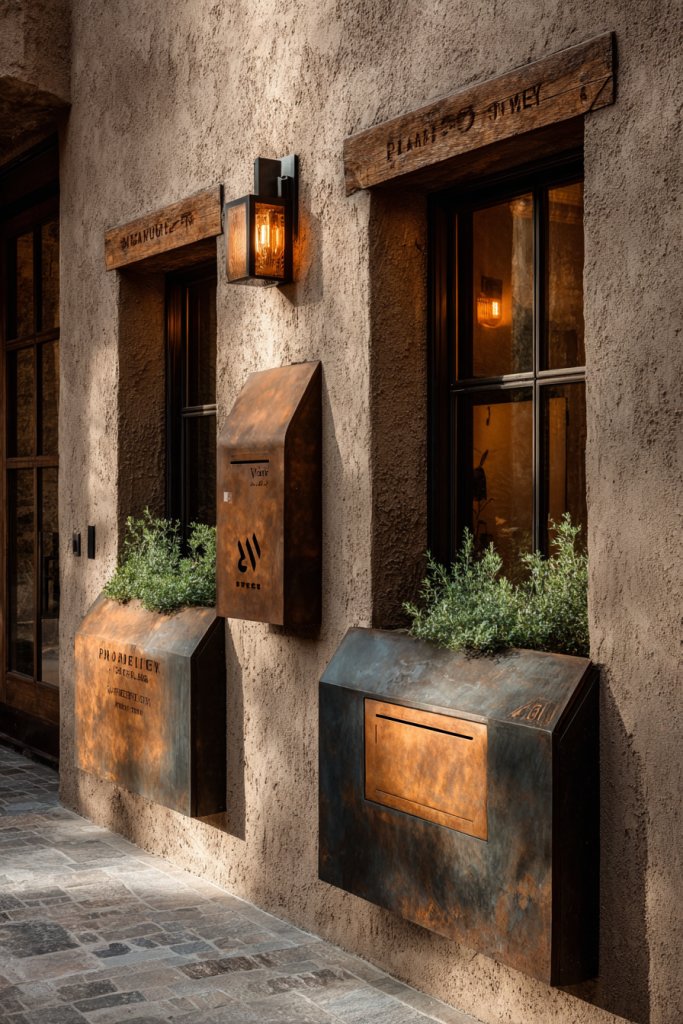
Plain exteriors can lack that wow factor. Metal accents—whether sleek or rustic—add instant sophistication or warmth, elevating your home’s style. They create visual interest and contrast that keeps the eye moving along your facade.
Picture a modern black metal awning over the front door, or rustic iron brackets supporting a porch roof. Metal railings with clean lines or wrought iron decorative elements add texture and shine. The reflective quality of metal enhances architectural features, giving depth and dimension to your exterior.
Choose matte, brushed, or polished finishes depending on your desired vibe. For contemporary homes, sleek steel or aluminum panels work well. Rustic structures benefit from weathered iron or copper accents that develop a patina over time. Mix and match metals for an eclectic, layered look.
Select high-quality, weather-resistant metals suited for outdoor use. Securely fasten accents using appropriate anchors, ensuring stability against wind and weather. For structural elements like railings or supports, professional installation guarantees safety. Regular maintenance—like cleaning and rust treatment—keeps metal components looking their best.
Add decorative metal art, custom house numbers, or unique light fixtures. Use contrasting finishes—like black fixtures with copper accents—for visual pop. Incorporate metal panels or screens as privacy or sun-shading elements. Personal touches, like engraved plaques or vintage hardware, personalize the accents.
Metal accents lend a contemporary or rustic edge that can redefine your exterior aesthetic. They’re durable, low-maintenance, and versatile. When integrated thoughtfully, metal elements make your home look modern, classic, or anything in between, giving your curb appeal a serious upgrade.
11. Design a Distinctive Roofline or Architectural Details
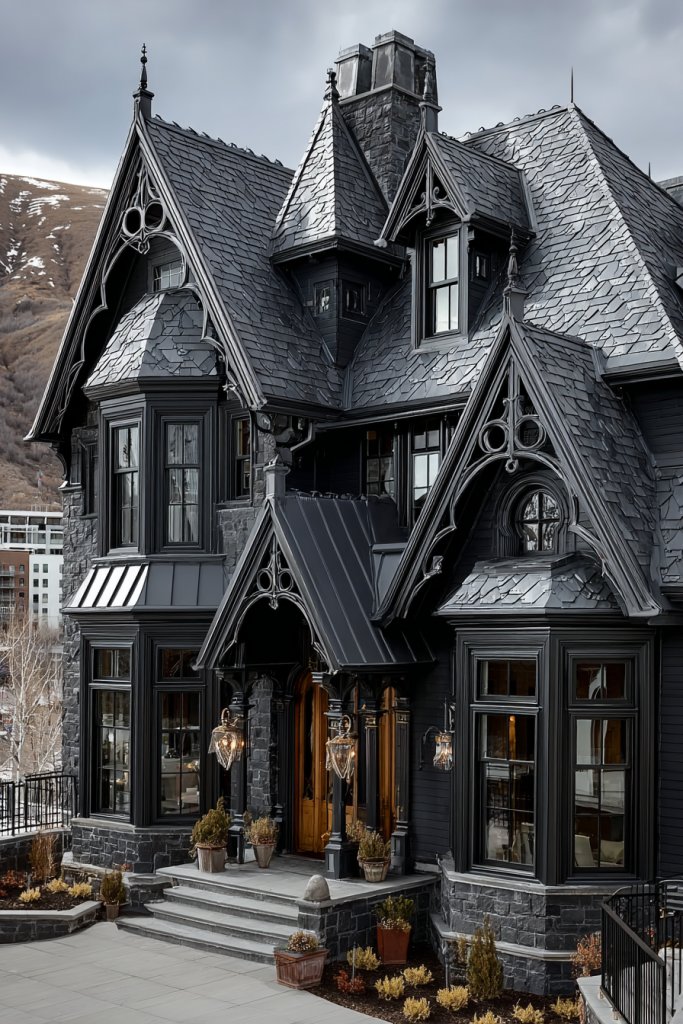
A flat or boring roofline can make a home look boxy and uninspired. Unique roof shapes and architectural details add character and visual interest. They turn your house from ordinary into eye-catching architecture that commands attention.
Imagine a gambrel or mansard roof, adding height and drama. Decorative dormers, gables, or ornate trim create depth and complexity. Architectural details like brackets, corbels, or decorative trim embellish the silhouette, making your home stand out. The varied rooflines cast interesting shadows and highlight craftsmanship.
Select roof styles that suit your home’s architecture—hip, gable, or shed roofs for different vibes. Add dormers for extra space and charm or decorative trim for sophistication. In modern designs, flat roofs with clean lines and rooftop terraces are trending. Seasonal accents, like snow or autumn foliage, enhance the visual impact.
Work with an architect or roofing specialist to design a distinctive roofline. Choose durable materials like asphalt shingles, metal, or tiles that match your style. Ensure proper drainage and ventilation are incorporated into the design. Installation involves precise framing and finishing to ensure stability and longevity. Regular inspections maintain the integrity of complex rooflines.
Accent your roof with decorative brackets or finials. Add contrasting fascia or decorative shingles for extra detail. Use lighting to highlight architectural features at night. Personalize with custom shapes, colors, or textured roofing materials that reflect your personality.
A distinctive roofline adds instant curb appeal and a signature look. It demonstrates architectural creativity and attention to detail. With the right design, your home becomes a landmark that captures admiration and envy.
12. Use Patterned or Textured Pathways to Guide the Eye
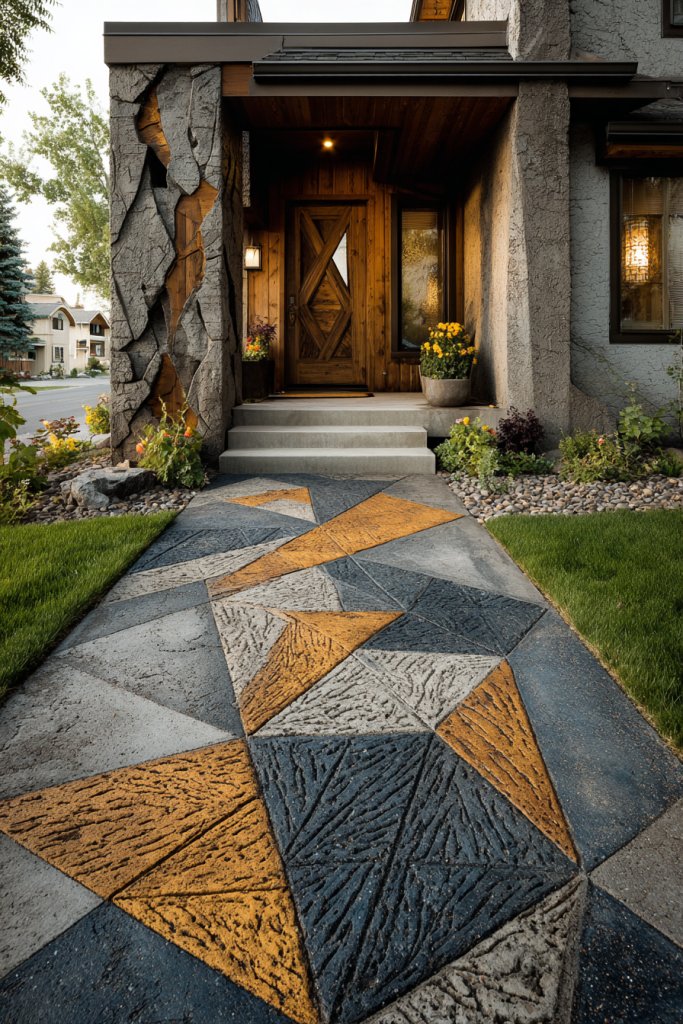
A plain concrete walkway can be uninspiring and forgettable. Patterned or textured pathways create visual interest and guide visitors naturally to your door. They turn an ordinary route into a design feature that enhances your home’s exterior charm.
Picture stamped concrete with intricate patterns mimicking cobblestones or brick. Or imagine a winding paver pathway with textured surfaces, inviting exploration. Adding borders of contrasting colors or materials frames the path beautifully. The tactile surface adds depth and movement, leading the eye toward your home.
Choose from stamped concrete, brick, pavers, or gravel with textured overlays. Patterns can be geometric, floral, or abstract, depending on your style. Seasonal elements, like leaf-shaped pavers or snowflake patterns, add a festive touch. For small yards, a narrow textured path creates an illusion of space.
Start by clearing and leveling the area. Install a suitable base—sand or gravel—and compact it well. Lay your chosen material, ensuring proper spacing and alignment. Use a pattern stamp or textured overlays during installation. Seal surfaces if needed and add edging to keep the pathway neat. Regular cleaning maintains the pattern’s crispness.
Incorporate personalized patterns or motifs that reflect your personality—initials, family crests, or symbols. Use color treatments or contrasting borders to emphasize design. Integrate solar pathway lights or small garden sculptures along the edges for added charm. Seasonal decor, like pumpkins or lanterns, enhances the pathway’s appeal.
Patterned pathways elevate your landscape with artistry and function. They create a welcoming entrance and showcase your creative flair. A well-designed walkway makes your home feel thoughtfully curated and inviting to all passersby.
13. Install a Statement Garden Gate or Fence
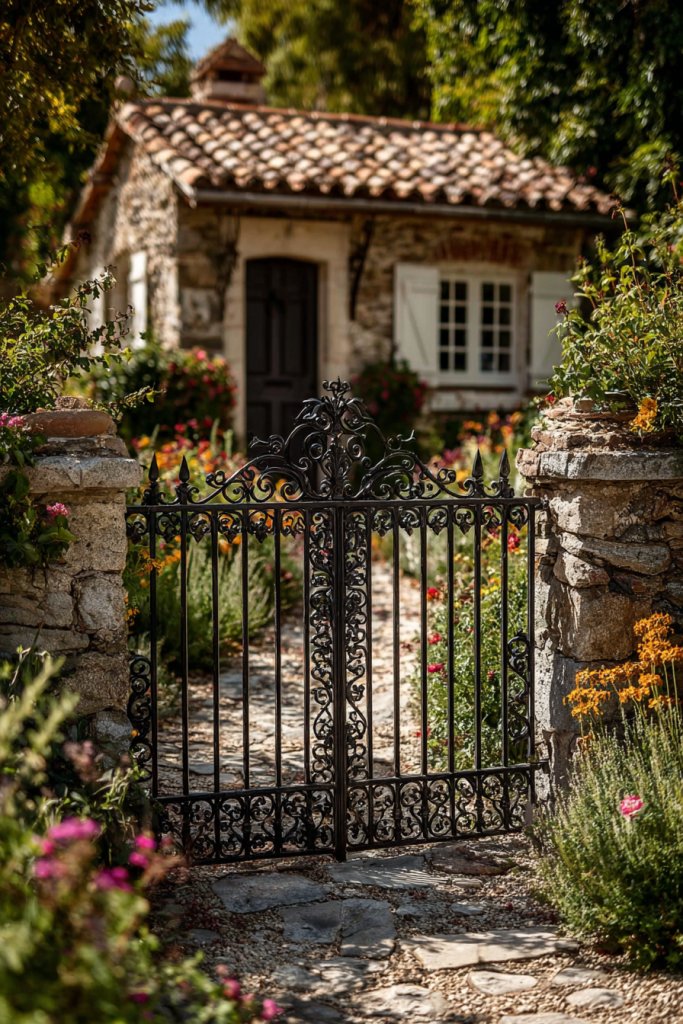
A plain fence or dull gate can make your home fade into the background. A statement gate or fence acts as a bold framing device that defines your property’s personality. It’s the first impression that hints at the style and vibe inside.
Imagine a wrought iron gate with intricate scrollwork opening onto a lush garden. Or a rustic wooden fence with distressed paint and decorative post caps. These elements add character, whether you want charming, modern, or farmhouse appeal. When designed well, the gate becomes a centerpiece that draws attention.
Select from ornate metal gates, minimalist panels, or natural wood slats. For security and privacy, opt for taller fences with decorative elements woven in. For a vintage look, incorporate distressed finishes and antique hardware. Larger gates can incorporate arched tops or custom motifs for extra drama.
Measure your opening carefully to ensure a perfect fit. Choose durable materials—galvanized steel, aluminum, or treated wood—that withstand weathering. Install posts securely into the ground with concrete, ensuring stability. Attach hinges and latches with galvanized hardware, and finish with protective coatings. Regular maintenance preserves the look and function.
Decorate gates with custom details like monograms, floral motifs, or sponsor logos. Incorporate lighting fixtures or decorative finials for added flair. Use color accents—like a bold black or soft pastel—to match your exterior. Seasonal decorations, like wreaths or ribbons, make the gate more inviting.
A standout gate or fence defines your property and elevates curb appeal. It offers privacy, security, and style, making your home a true reflection of your taste. When unique and well-maintained, it’s a feature that boosts confidence in your outdoor design choices.
14. Incorporate Contrasting Trim and Fascia
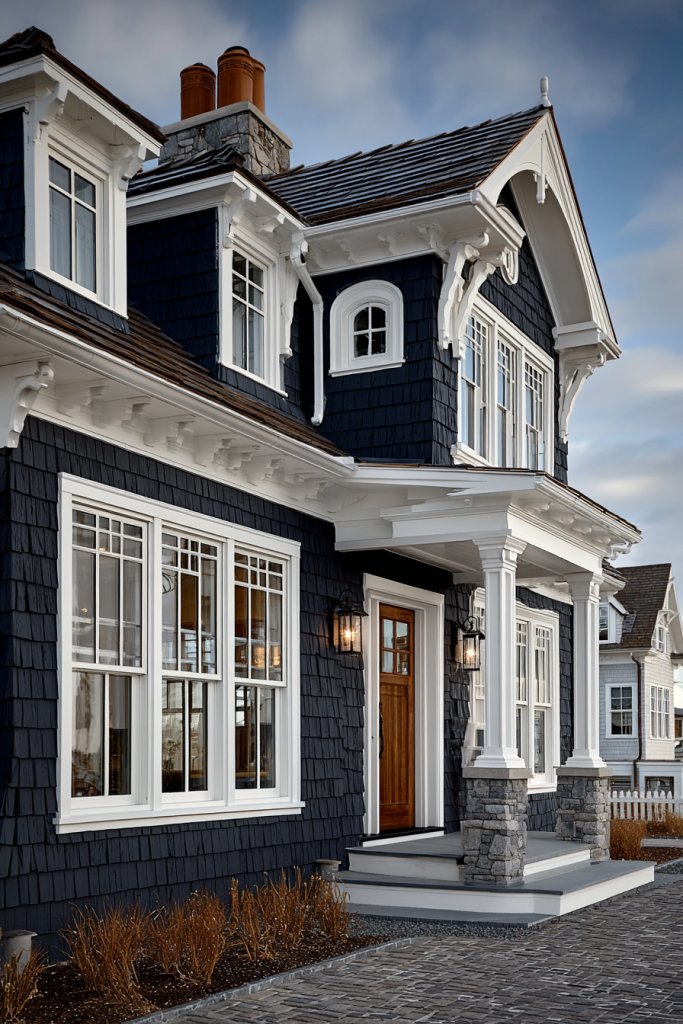
Many homes blend into the background because of monotone exteriors. Contrasting trim and fascia create visual boundaries that define architectural lines and add depth. This simple trick makes your house look sharper and more polished instantly.
Visualize white trim around dark siding or a bold color framing a neutral base. Highlight eaves, soffits, and fascia with a contrasting hue to emphasize rooflines. The sharp lines and color differentiation make details pop, giving your home a crisp, tailored appearance. It’s like adding a frame to a piece of art.
Choose colors that complement or provide stark contrast—think black trim on white siding or navy accents on gray. For a more subdued look, use tones within the same color family for a subtle contrast. Seasonal tweaks, like bright accent colors, can refresh the look periodically. Use different textures—matte, gloss, or satin—to add further interest.
Start by selecting your color palette carefully, considering your exterior hues. Use painter’s tape and high-quality exterior paint for clean lines. Paint eaves, fascia, window frames, and door trims consistently. For a professional finish, consider hiring a painter or using masking techniques. Regular touch-ups keep the contrast sharp.
Add decorative trim or molding for a more elaborate look. Use contrasting colors for shutters, window frames, or decorative panels. Incorporate seasonal accents—like holiday colors or themed motifs—within the trim’s palette. Personalize with custom engravings or embossed patterns.
Contrasting trim elevates your home’s architectural clarity and style. It’s a subtle yet powerful way to make your exterior look more intentional and refined. With a bit of paint and planning, you can create a striking, professional-quality finish that will turn heads.
15. Plant a Symmetrical or Asymmetrical Border Garden
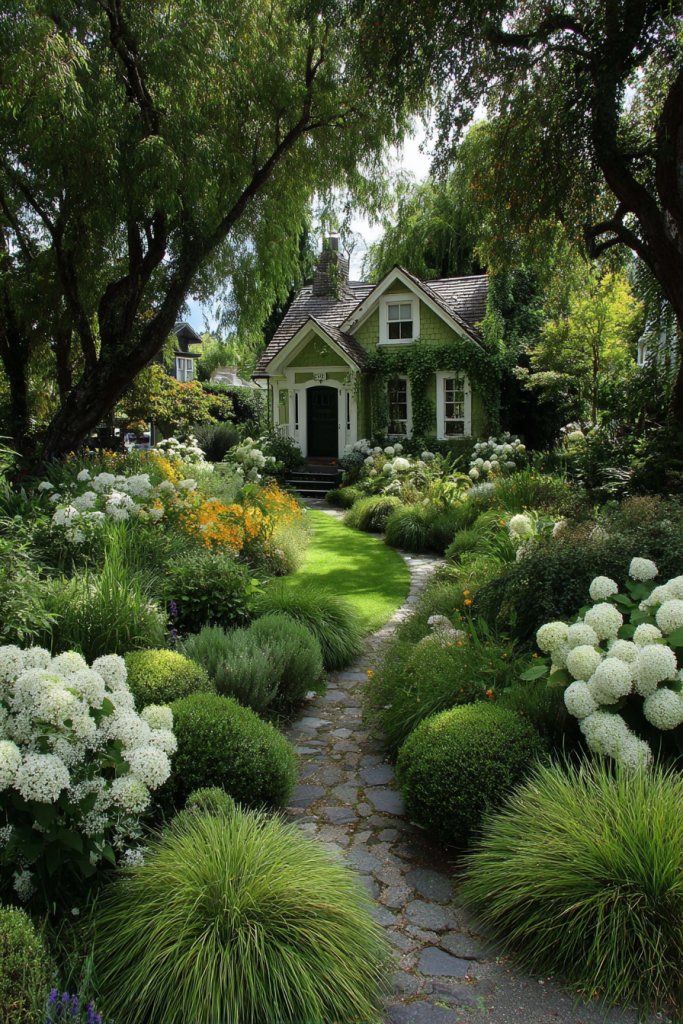
A bare or chaotic border can make your yard look unkempt or unfinished. Strategic planting in symmetrical or asymmetrical arrangements creates order and visual interest. It frames your home beautifully and adds seasonal charm.
Picture matching flower beds on each side of a pathway, filled with colorful blooms or lush greenery. Symmetrical planting creates a mirror image, enhancing formal elegance. Asymmetry, with varying heights and textures, adds a relaxed, natural feel. Both approaches define your boundaries and draw the eye toward your home.
Use evergreen shrubs for structure and seasonal flowers for color. Symmetry works well with formal styles, while asymmetry suits cottage or modern looks. Incorporate layers with taller plants in the back and shorter ones in front. Seasonal plantings like tulips in spring or mums in fall keep it fresh and inviting.
Plan your layout on paper first, considering sunlight and maintenance needs. Prepare beds by removing weeds and enriching soil. Plant in pairs or clusters for symmetry, or stagger for asymmetry. Add mulch to retain moisture and define borders sharply. Regular pruning and deadheading keep the garden tidy.
Incorporate decorative stones, sculptures, or engraved markers to personalize borders. Use color schemes that match your house or landscape theme. Mix textures—like soft grasses with bold flowering plants—for visual appeal. Seasonal decor, like pumpkins or lanterns, can add a festive touch.
Border gardens frame your home with beauty and structure. They boost curb appeal and reflect your personal style. With a thoughtful layout, your yard becomes a welcoming, scenic space that invites admiration and enjoyment.
16. Add a Cozy Seating Nook or Front Porch Swing
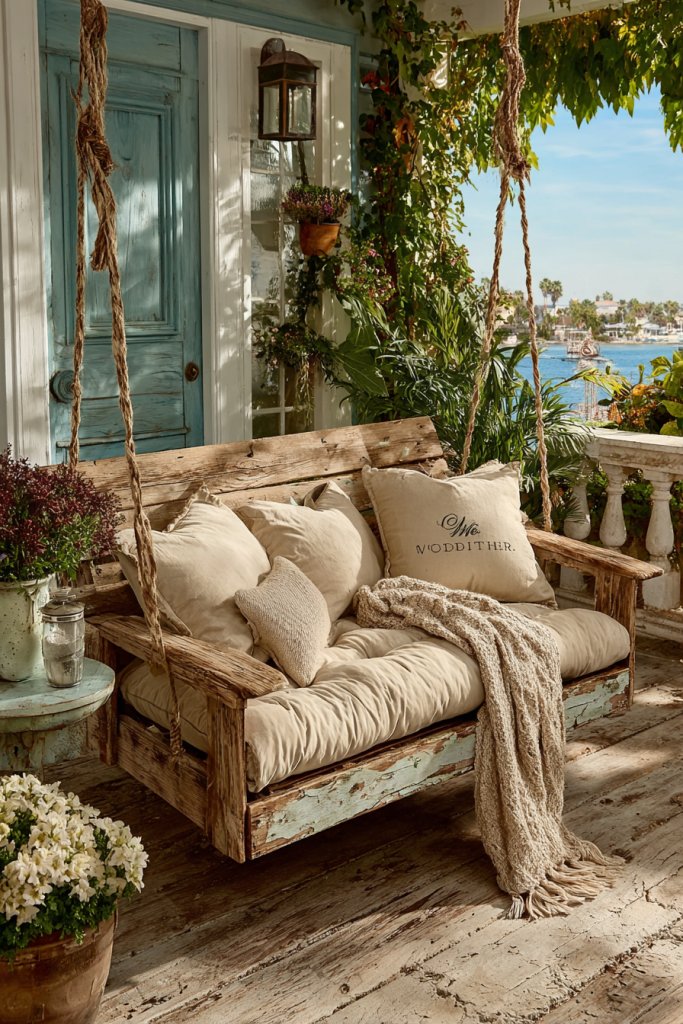
Your front yard should be more than just eye candy—it should invite you to relax and unwind. A cozy seating nook or porch swing creates an outdoor retreat that enhances your home’s charm. It’s the perfect spot for morning coffee or evening chats.
Imagine a vintage swing suspended from a sturdy porch ceiling, with plush cushions and a throw blanket. Or picture a quaint corner with a weathered wooden bench surrounded by potted plants and lanterns. The inviting setup makes your home feel warm and approachable, encouraging visitors to linger.
Select furniture that matches your aesthetic—rustic wood, wrought iron, or modern composite. For small spaces, a simple bench or a pair of chairs suffices. Larger porches can accommodate a loveseat or a swing. Add cushions and throws for comfort and style, changing them seasonally.
Begin by assessing your porch or yard space to determine suitable seating. Securely install a swing or place furniture on a stable surface. Choose weather-resistant cushions and fabrics suited for outdoor use. Decorate with string lights, planters, or small tables to create a cozy ambiance. Regular cleaning and maintenance keep it inviting.
Add personalized touches like monogrammed cushions or decorative pillows. Incorporate seasonal accents—like a cozy blanket in winter or floral cushions in summer. Use decorative lanterns or fairy lights to enhance ambiance at night. Personal touches make the space uniquely yours.
A cozy seating nook invites family and friends to gather outside, extending your living space. It boosts curb appeal and creates a welcoming atmosphere. When styled thoughtfully, it transforms your exterior into a charming, functional retreat.
17. Use Large-Scale Outdoor Wall Art or Murals (Weatherproofed)
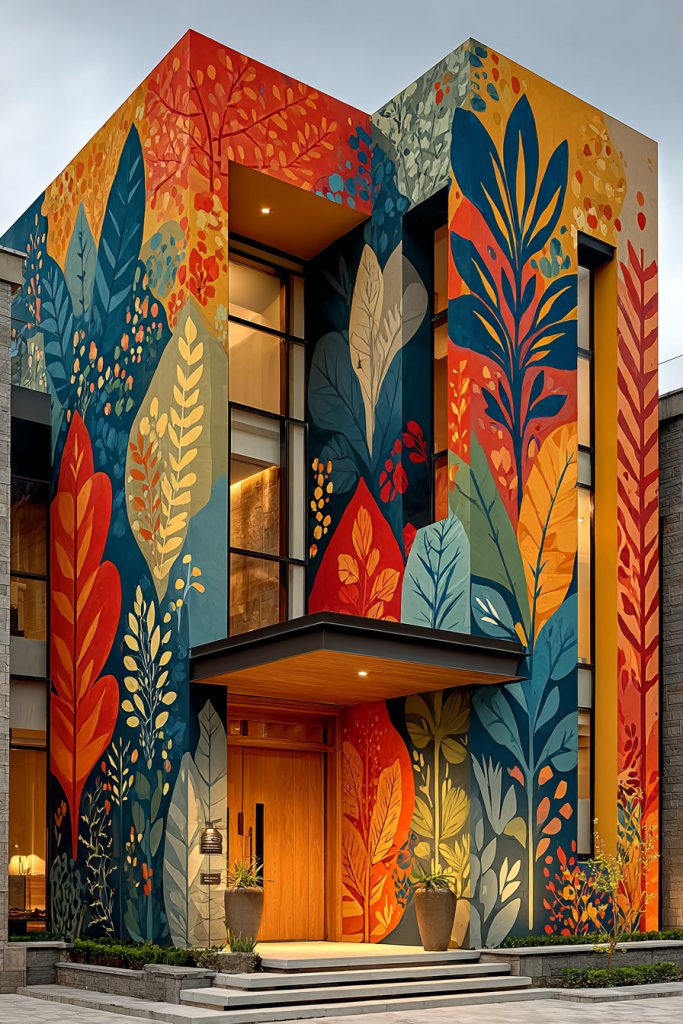
Blank exterior walls can make a home look plain or unfinished. Large-scale outdoor art or murals turn bare surfaces into striking focal points. They inject personality, color, and a modern edge that makes your house stand out.
Visualize a mural depicting a scenic landscape or abstract design painted on a large exterior wall. Or imagine a textured metal panel with intricate cutouts that catch light and shadow. These artistic elements add depth, drama, and a unique signature to your home’s facade.
Choose murals that match your style—bold graphics for modern homes or nature scenes for rustic charm. Use weatherproof paints and sealants to ensure longevity. Collaborate with local artists or DIY with stencils for a personal touch. Incorporate textured panels or decorative art pieces for added dimension.
Prepare the wall surface—clean and repair any damage. Use high-quality, weather-resistant paints or materials suited for outdoor murals. For large designs, consider professional artists or muralists. Seal the finished artwork with protective coatings to prevent fading and damage. Regular maintenance preserves vibrancy.
Personalize murals with your favorite themes or family motifs. Add embellishments like metal accents or lighting to highlight the art at night. Incorporate complementary architectural features, like decorative brackets or trim, to frame the artwork. Seasonal or thematic updates can keep it fresh.
Outdoor murals and wall art turn your home into a canvas of creativity. They showcase your personality and artistic flair, making your property memorable. With the right design and materials, you can create a stunning, durable feature that boosts curb appeal and pride.
18. Incorporate Textured or Patterned Exterior Paint Techniques
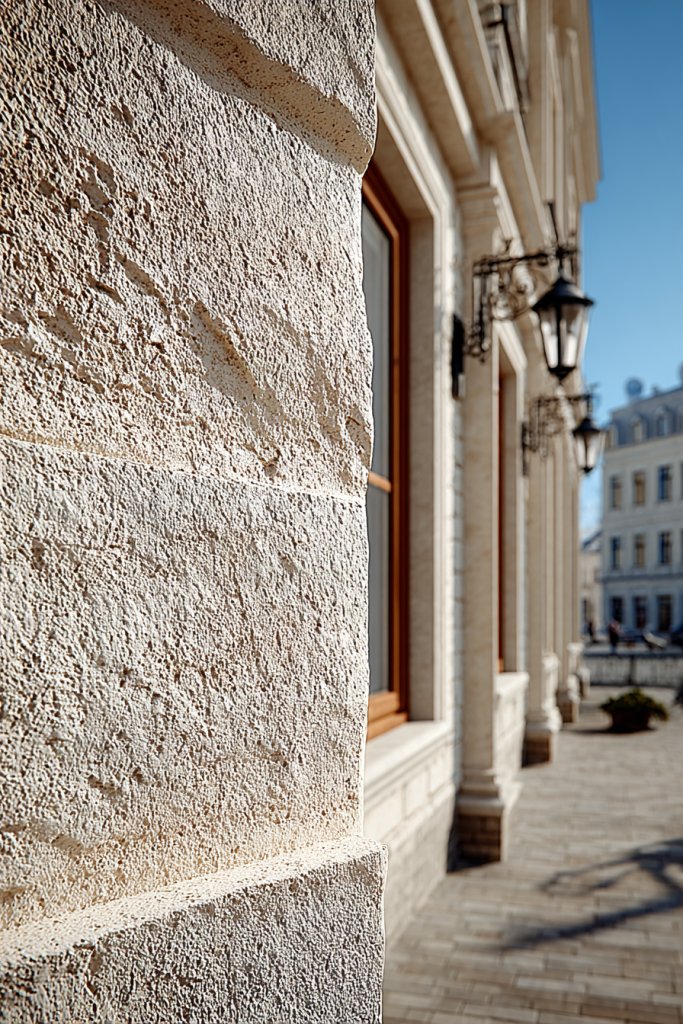
Flat, single-tone walls can feel dull and uninspired. Textured or patterned paint techniques add visual interest and depth, making your exterior more engaging. They showcase craftsmanship and creativity, elevating your home’s aesthetic.
Imagine walls finished with sponging, rag rolling, or stenciling, creating subtle patterns or rich textures. A gentle swirl or stippled effect adds dimension, while colorful patterns can turn a plain surface into a piece of art. These techniques catch the light differently, adding dynamism to your facade.
Choose techniques that match your exterior style—soft sponge textures for a cottage look or bold stenciled patterns for contemporary homes. Use colors that complement or contrast your base color, creating visual pop. Seasonal color updates or accents can refresh the look without major overhaul.
Start with a clean, dry surface. Select the technique—sponging, rag rolling, or stenciling—and gather the necessary tools. Practice on a scrap surface first. Apply a base coat, then add textured or patterned layers, working in sections. Seal with a weatherproof, UV-resistant finish for durability. Regular cleaning preserves the effect.
Coordinate colors with architectural trims or accents for a cohesive look. Use stencils to add personalized motifs or initials. Incorporate metallic or pearl finishes for a subtle shimmer. Seasonal updates with different patterns or colors keep your exterior fresh.
Creative paint techniques transform flat surfaces into textured works of art. They reflect your personality and taste, making your home more memorable. With patience and practice, you can craft a distinctive exterior that impresses everyone who passes by.
19. Install a Distinctive Front Entry Canopy or Awning
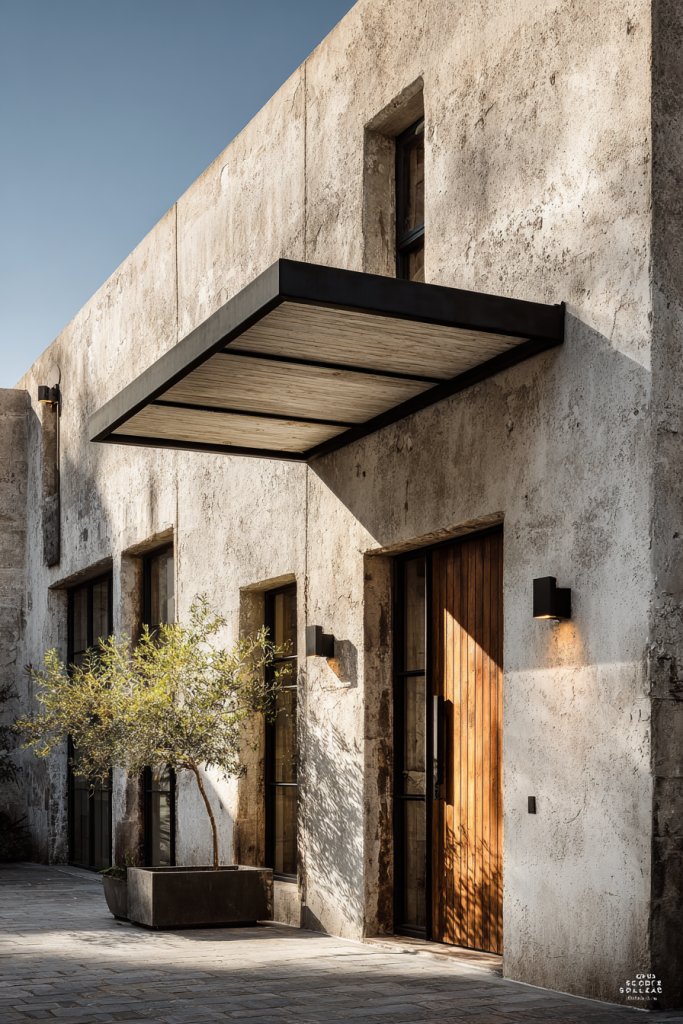
A plain front door can feel uninspired or exposed to the elements. A distinctive canopy or awning adds charm and protection, elevating your home’s entrance. It combines form and function, making your home more inviting and weather-resistant.
Picture a curved iron canopy with ornate detailing over your door, or a sleek, modern aluminum awning with clean lines. The canopy creates a frame that draws attention to your entry, adding architectural interest. The shadow play and textures enhance curb appeal, especially in inclement weather.
Choose materials like wrought iron, wood, or metal for different aesthetics. For traditional homes, carved wood or decorative scrollwork works well. Modern designs favor minimal, flat overhangs with integrated lighting. Size and shape can be customized to suit your entry’s proportions and style.
Determine the appropriate size and style based on your entrance. Consult with a professional for structural support and safety. Install robust brackets or supports into the wall, ensuring stability. Attach the canopy securely, sealing joints against weather. Add lighting underneath for nighttime visibility. Regular inspections prevent sagging or damage.
Decorate the canopy with string lights, hanging planters, or seasonal ornaments. Use contrasting colors or materials to make it stand out. Incorporate your house number or monogram into the design. Add weather-resistant fabrics or decorative trim for extra flair.
A well-designed canopy creates a dramatic focal point and enhances your home’s style. It offers practical benefits while making your entry more inviting. With the right choice, your front door becomes a showstopper that boosts curb appeal and pride.
20. Add Architectural Details like Cornices or Dentil Molding
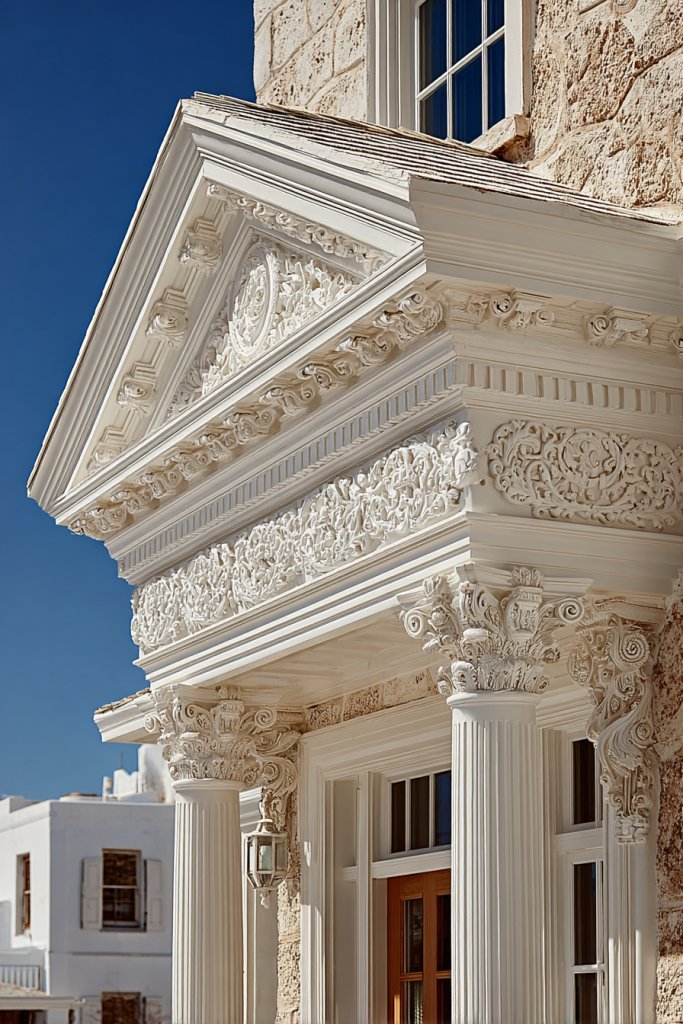
Flat, featureless exteriors lack character and sophistication. Architectural details like cornices, dentil molding, or decorative trim add depth and elegance. They elevate your home’s silhouette, giving it a timeless, crafted appearance.
Imagine ornate dentil molding accentuating the roofline or a detailed cornice framing the top of your walls. These features cast subtle shadows and highlight craftsmanship. They create a layered, refined look that draws the eye and enhances curb appeal, especially when paired with contrasting paint or finishes.
Select from traditional classical styles or modern minimalist details. Use materials like wood, polyurethane, or fiber cement for durability and ease of installation. For a subtle upgrade, add small trim or rosettes around windows or doors. Larger, more ornate features suit historic or grand homes.
Plan your architectural enhancements with a designer or contractor. Measure and select appropriate materials to match your home’s style. Install securely with weatherproof fasteners, ensuring alignment and stability. Paint or finish to match or contrast your exterior palette. Regular maintenance preserves the intricate details.
Add decorative medallions, floral motifs, or custom carvings for a personalized touch. Use contrasting colors or metallic finishes to highlight details. Incorporate lighting to showcase architectural features at night. Seasonal accents or wreaths can complement the overall look.
Architectural details lend sophistication and a bespoke feel to your home. They demonstrate attention to detail and elevate the overall aesthetic. When done thoughtfully, these features create a distinctive, elegant exterior that makes a lasting impression.
21. Maintain a Clean, Well-Defined Landscape Edge
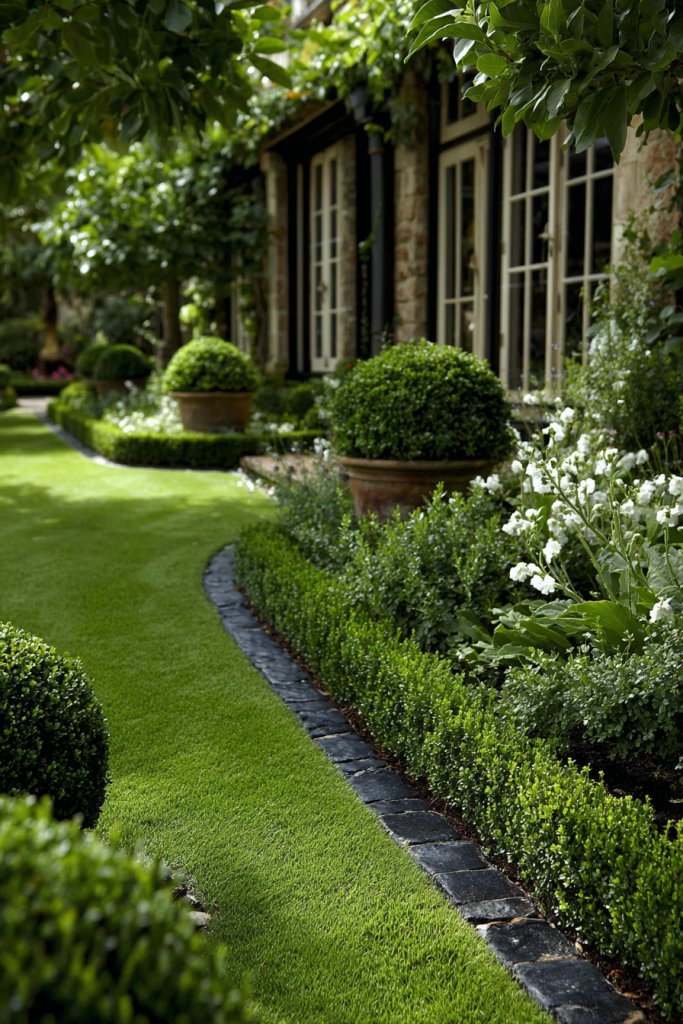
Overgrown or sloppy landscape edges can ruin an otherwise beautiful exterior. Clean, well-defined borders create a polished look that ties your entire landscape together. They emphasize your home’s architecture and make maintenance easier.
Picture sharply edged flower beds with crisp mulch lines or stone borders framing the lawn. This neat separation makes plants pop and prevents grass or weeds from spilling into pathways. The clean lines create a tidy, professional appearance that invites admiration.
Use edging materials like bricks, pavers, metal, or plastic for different styles and budgets. For a natural look, try rounded stones or wood timbers. For formal gardens, concrete or stone borders provide sharp, durable edges. Seasonal touches like fresh mulch or decorative stones can refresh the look.
Mark your borders with spray paint or string lines for accuracy. Dig a shallow trench to set your edging materials securely. Compact the base and install the border, ensuring it’s level and tightly fitted. Apply mulch or gravel to fill gaps and retain the shape. Regularly maintain and replace materials as needed.
Personalize with decorative stones, engraved bricks, or painted edges. Use contrasting colors or textures to highlight the borders. Incorporate lighting along the edges for evening appeal. Add seasonal accents like pumpkins or lanterns to keep it lively.
A neat landscape edge frames your yard beautifully, making it feel organized and cared for. It significantly boosts curb appeal and reflects your pride in your home. With some effort, your exterior landscape becomes a tidy, inviting space that everyone admires.
Conclusion
With a diverse range of exterior design ideas, you have plenty of options to upgrade your home’s curb appeal and reflect your personal style. From eye-catching color schemes to innovative architectural touches, these ideas can inspire you to create a stunning first impression. Don’t hesitate to experiment and bring your vision to life—your dream home exterior is within reach. Start today and turn your house into a true standout!
Leave a Reply